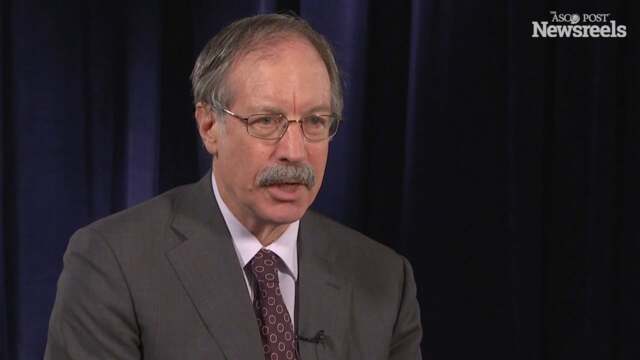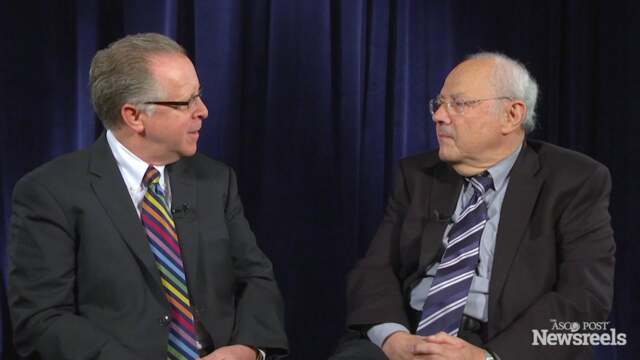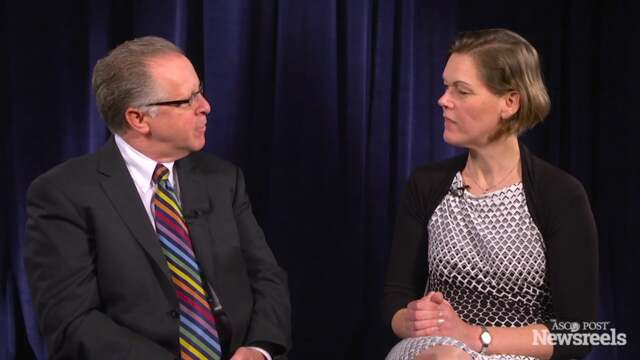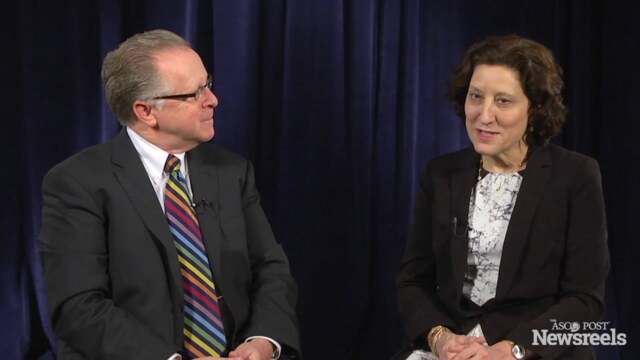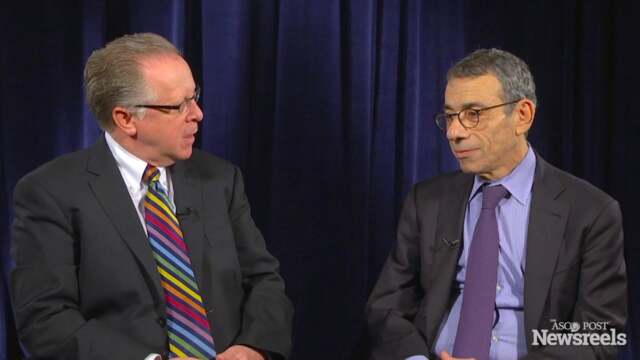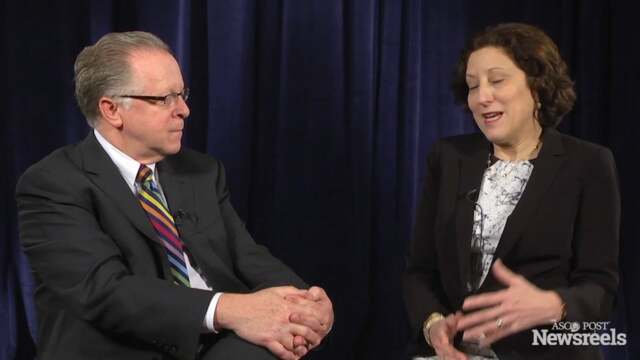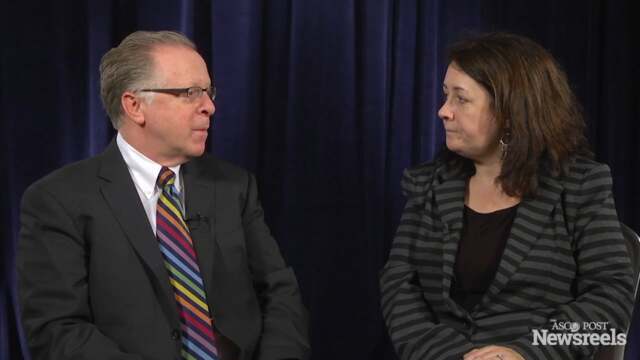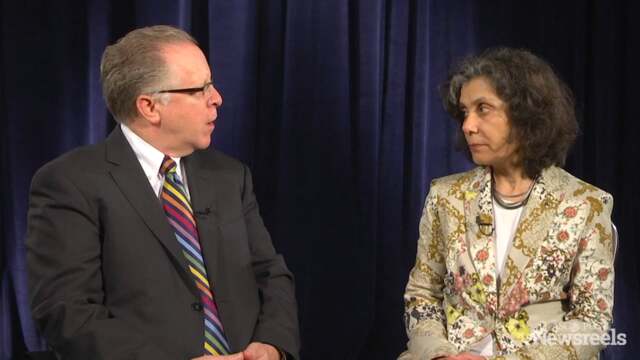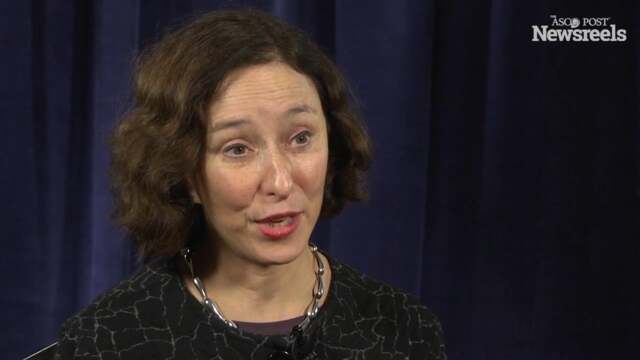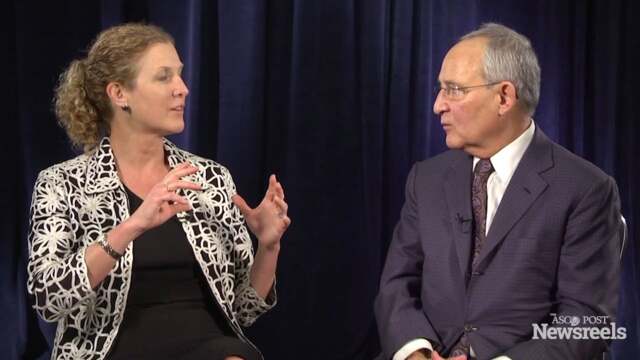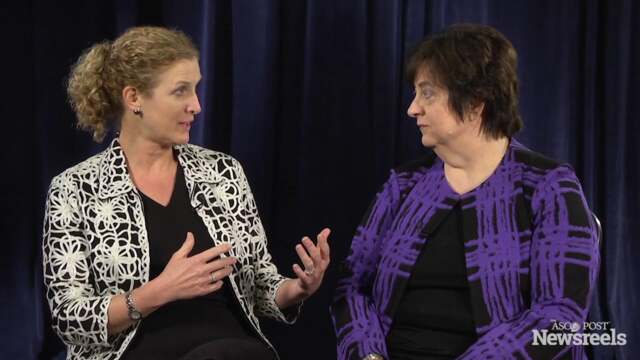Nodal Irradiation in Node-Positive Breast Cancer: It Is Not Time to Change Practice
Management of the regional nodes in breast cancer has evolved from the era of the extended radical mastectomy to exclusion of axillary dissection in appropriately selected patients. Throughout this evolution, studies of nodal irradiation have been shown to improve locoregional control, usually...
Regional Nodal Irradiation in Early Breast Cancer Yields Significant Disease-Free Survival Benefit in Two Trials
Two phase III trials recently reported in The New England Journal of Medicine indicated that the addition of regional nodal irradiation was associated with no or marginal overall survival benefit but significantly improved disease-free survival in patients with early-stage breast cancer.1,2 NCIC...
ASCO Clinical Practice Guideline: Use of Biomarkers to Guide Systemic Therapy for Women With Metastatic Breast Cancer
As reported in the Journal of Clinical Oncology by Catherine Van Poznak, MD, and colleagues, ASCO has issued a clinical practice guideline on the use of biomarkers to guide decisions on systemic therapy in women with metastatic breast cancer.1 The statement is based on an ASCO expert panel review...
Closing the Racial Survival Disparity Gap in Breast Cancer: Models for Change From Chicago, New York, and Beyond
It has long been said that white women of European ancestry are more likely to be diagnosed with breast cancer, but African American women are more likely to die of it. This statement has introduced multiple articles on the topic of the racial survival disparity in breast cancer, including our own...
Reducing Racial Disparities in Breast Cancer Incidence and Mortality Trends to Improve Outcomes
A recent report by DeSantis and colleagues from the American Cancer Society, summarized in this issue of The ASCO Post, presented breast cancer incidence and mortality data from an extensive analysis of the U.S. system of state-based tumor registries.1 The data showed that the incidence of breast...
Convergence of Breast Cancer Incidence but Continued Divergence of Mortality in Black Women and White Women
In an article published in CA: A Cancer Journal for Clinicians, Carol E. DeSantis, MPH, and colleagues from the American Cancer Society reported that the incidence of breast cancer in black women has caught up to that in white women, whereas the risk of mortality continues to be higher in black...
Neoadjuvant Chemotherapy Appears to Have No Effect on Short-Term Outcomes in Breast Cancer Surgery
Patients who received neoadjuvant chemotherapy within 30 days prior to breast cancer surgery did not appear to be at increased risk for overall postoperative complications, according to a study presented at the 2015 Breast Cancer Symposium.1 “Although on unadjusted analysis there were more...
Tumor Profiling of Breast Tumors in Older Patients Reveals Differences From Those of Younger Patients
Using multiplatform profiling, researchers have identified potentially targetable biomarker aberrations in a large cohort of geriatric breast tumors.1 According to the study, presented at the 2015 Breast Cancer Symposium, these data may help researchers to design clinical trials focusing on...
Combining Molecular-Driven Approach and Immunotherapy to Improve Treatment for Patients With Inflammatory Breast Cancer
We have a responsibility to develop better treatment for inflammatory breast cancer,” Massimo Cristofanilli, MD, FACP, told participants at the 17th Annual Lynn Sage Breast Cancer Symposium in Chicago. As recently appointed Associate Director of Translational Research and Precision Medicine at the ...
ASCO Guideline on the Use of Biomarkers in Treatment Decisions in Metastatic Breast Cancer: Shedding Light on an Often Mysterious Art
As summarized in this issue of The ASCO Post (see "ASCO Clinical Practice Guideline: Use of Biomarkers to Guide Systemic Therapy for Women With Metastatic Breast Cancer"), Van Poznak and colleagues recently presented an ASCO clinical practice guideline on the use of biomarkers for decisions...
Mohamed Bentires-Alj, PharmD, PhD, Honored With 2015 AACR Outstanding Investigator Award for Breast Cancer Research
Mohamed Bentires-Alj, PharmD, PhD, was recognized with the 8th Annual American Association for Cancer Research (AACR) Outstanding Investigator Award for Breast Cancer Research, funded by Susan G. Komen. He received the award at the 2015 San Antonio Breast Cancer Symposium. The AACR Outstanding...
AACR Recognizes Anne-Lise Børresen-Dale, DSc, With 2015 Distinguished Lectureship in Breast Cancer Research
Anne-Lise Børresen-Dale, DSc, Professor at the University of Oslo and Head of the Department of Genetics at the University Hospital Radiumhospitalet in Oslo, Norway, was honored with the 8th Annual American Association for Cancer Research (AACR) Distinguished Lectureship in Breast Cancer Research...
Breast Care Services at Henry Ford Health System Gains New Director, Three New Surgeons
Internationally renowned breast cancer surgeon Lisa A. Newman, MD, MPH, has joined Henry Ford Health System to lead its metro Detroit breast cancer program and new international breast cancer research center. She begins work in December as the Director of the Breast Cancer Program at Henry Ford....
Ductal Carcinoma in Situ and Relevant Endpoints for Omission of Standard Treatments: Are We There Yet?
The optimal management strategy for ductal carcinoma in situ has become increasingly controversial with respect to potential overdiagnosis and overtreatment. Much of the controversy for ductal carcinoma in situ stems from its exceptional breast cancer–specific survival, which approaches close to...
Surgical Excision Without Radiation Therapy in Women With Low-Risk Ductal Carcinoma in Situ
Lawrence J. Solin, MD, of Albert Einstein Healthcare Network, Philadelphia, and colleagues reported the 12-year results from the ECOG-ACRIN E5194 trial in the Journal of Clinical Oncology. Among women with ductal carcinoma in situ with low-risk clinical and pathologic characteristics, they found...
Breast Cancer Survivors May Expect More Extensive or Frequent Follow-up Testing Than Recommended
Patients who have been treated for breast cancer may overestimate the value of follow-up testing and may expect—or even ask for—more testing than recommended, Harold J. Burstein, MD, PhD, of the Dana-Farber Cancer Institute and Harvard Medical School, Boston, told participants at the Lynn Sage...
Partnering Therapies for Estrogen Receptor–Positive Breast Cancer Requires Close Monitoring and Patient Communication
Partnering endocrine therapy with new targeted agents for women with estrogen receptor–positive breast cancer “changes the nature of endocrine therapy from something easily tolerated, with not a lot that you have to do as physicians to monitor it,” William J. Gradishar, MD, of the Robert H. Lurie...
Adjuvant Denosumab Improves Disease-Free Survival in Estrogen Receptor–Positive Postmenopausal Breast Cancer
There is good news about denosumab (Prolia). The primary analysis of the ABCSG-18 trial showed that adjuvant denosumab (given at low doses) reduces the risk of clinical fracture by 50% in postmenopausal women with early breast cancer who are taking an aromatase inhibitor.1 More good news is that...
Patients With Incomplete Response to Neoadjuvant Chemotherapy Benefit From Capecitabine
Treatment with capecitabine increased disease-free and overall survival in breast cancer patients with residual disease after neoadjuvant chemotherapy, according to a study reported by researchers from Japan and Korea at the 2015 San Antonio Breast Cancer Symposium.1 “It has been unclear whether...
New Study Suggests Benefits of Regular Mammography Extend to the Elderly
Breast cancer afflicts 1 in 8 women in their lifetime, and 1 in 25 die from this disease. Although a number of randomized trials have demonstrated the clear benefits of mammography screening in women up to age 74 on reducing mortality, data are sparse in women over age 74, especially among...
National Cancer Database Study Indicates Racial Differences in Neoadjuvant Chemotherapy Use in Women With Breast Cancer
In a study reported in the Journal of Clinical Oncology, Killelea et al found that chemotherapy, particularly neoadjuvant chemotherapy, was more frequently given to black, Hispanic, and Asian women vs white women with stage I to III breast cancer, with the difference largely attributable to more...
Travel Distance Is Still a Barrier to Breast Reconstruction After Mastectomy
Long travel distances continue to be a significant obstacle to breast reconstruction after mastectomy for breast cancer, according to a study published by Abornoz et al in Plastic and Reconstructive Surgery. “While greater patient awareness and insurance coverage have contributed to greater...
Patient-Reported Outcomes With Adjuvant Anastrozole vs Tamoxifen in Postmenopausal Women With Ductal Carcinoma in Situ
As reported in The Lancet and at the recent San Antonio Breast Cancer Symposium, Ganz et al found differences in patient-reported outcomes with anastrozole vs tamoxifen in the phase III National Surgical Adjuvant Breast and Bowel Project (NSABP) B-35 trial in postmenopausal women with hormone...
Jack Cuzick, PhD, FMedSci, on DCIS Recurrence Rates: Anastrozole vs Tamoxifen
Jack Cuzick, PhD, FMedSci, of Queen Mary, University of London, discusses his phase III study on postmenopausal women with DCIS who had similar outcomes whether they took tamoxifen or anastrozole for 5 years after surgery. (Abstract S6-03)
Andrew Seidman, MD, and Norman Wolmark, MD, on NSABP Clinical Trials and Management of Early Breast Cancer
Andrew Seidman, MD, of Memorial Sloan Kettering Cancer Center, and Norman Wolmark, MD, of Allegheny General Hospital, discuss the landmark trials of NSABP that have led to profound changes in breast cancer treatment. (Abstract ML-1)
Lori Pierce, MD, on Breast Cancer Radiotherapy: Late Side Effects
Lori J. Pierce, MD, of the University of Michigan Health System, discusses findings on second cancer incidence and non-breast cancer mortality among 40,000 women in 75 clinical trials. (Abstract S5-08)
Andrew Seidman, MD, and Hope Rugo, MD, on Advanced Breast Cancer: KEYNOTE-028 Study Results
Andrew Seidman, MD, of Memorial Sloan Kettering Cancer Center, and Hope S. Rugo, MD, of the University of California, San Francisco, discuss preliminary efficacy and safety findings of pembrolizumab in patients with PD-L1–positive, estrogen receptor-positive/HER2-negative disease. (Abstract S5-07)
Andrew Seidman, MD, and Erica Mayer, MD, MPH, on Results of the PALLAS Clinical Trial
Andrew Seidman, MD, of Memorial Sloan Kettering Cancer Center, and Erica L. Mayer, MD, MPH, of the Dana-Farber Cancer Institute, discuss this phase 3 trial of palbociclib with adjuvant endocrine therapy vs endocrine therapy alone for HR-positive/HER2-negative early breast cancer. (Abstract OT1-03-21)
Andrew Seidman, MD, and Sabine Seisling, PhD, on Early-Stage Breast Cancer Outcomes: Breast-Conserving Therapy vs Mastectomy
Andrew Seidman, MD, of Memorial Sloan Kettering Cancer Center, and Sabine Siesling, PhD, of the Netherlands Comprehensive Cancer Organization, discuss the improved overall survival after 10 years in women who received breast-conserving surgery compared with those who received mastectomy with radiation treatment. (Abstract S3-05)
Andrew Seidman, MD, and Hope Rugo, MD, on Reducing Alopecia: FDA Approves New Device
Andrew Seidman, MD, of Memorial Sloan Kettering Cancer Center, and Hope S. Rugo, MD, of the University of California, San Francisco, discuss the recent approval of a cooling cap to reduce hair loss during chemotherapy.
Clifford Hudis, MD, and Joseph Sparano, MD, on Results from DBCG778: Expert Perspective
Clifford A. Hudis, MD, of Memorial Sloan Kettering Cancer Center, and Joseph A. Sparano, MD, of Montefiore Medical Center, discuss this study of high-risk premenopausal luminal A breast cancer patients receiving adjuvant chemotherapy (Abstract S1-08).
Andrew Seidman, MD, and Eric Winer, MD, on Triple-Negative Breast Cancer: Results of the CALGB Alliance Trial
Andrew Seidman, MD, of Memorial Sloan Kettering Cancer Center, and Eric P. Winer, MD, of the Dana-Farber Cancer Institute, discuss the results of this study that showed pathologic complete response to presurgery chemotherapy improved survival (Abstract S2-05).
Andrew Seidman, MD, and Hope Rugo, MD: Less is More: Scaling Back Breast Cancer Treatment
Andrew Seidman, MD, of Memorial Sloan Kettering Cancer Center, and Hope S. Rugo, MD, of the University of California, San Francisco, discuss findings on de-escalating systemic therapy for breast cancer (Abstract ES6-3).
Andrew Seidman, MD, and Ruth O'Regan, MD: Update on Early Breast Cancer
Andrew Seidman, MD, of Memorial Sloan Kettering Cancer Center, and Ruth M. O’Regan, MD, of the University of Wisconsin, review practice-changing research in 2015 that was focused on early-stage breast cancer.
Andrew Seidman, MD, and Seema Khan, MD, MPH on Controversies in the Management of DCIS
Andrew Seidman, MD, of Memorial Sloan Kettering Cancer Center, and Seema A. Khan, MD, MPH, of the Lynn Sage Comprehensive Breast Center, discuss the session moderated by Dr. Khan on this important topic (Session ES8).
Clifford Hudis, MD, and Carlos Arteaga, MD, on Metabolic Syndrome and Obesity in Breast Cancer
Clifford A. Hudis, MD, of Memorial Sloan Kettering Cancer Center, and Carlos L. Arteaga, MD, of Vanderbilt University, discuss the roles of IGF/insulin signaling, adipokines and inflammation, and metformin and lifestyle change in breast cancer and risk for the disease.
Clifford Hudis, MD, and Julia White, MD, on Early-Stage Breast Cancer: Hypofractionated Radiotherapy
Clifford A. Hudis, MD, of Memorial Sloan Kettering Cancer Center, and Julia R. White, MD, of Ohio State University Comprehensive Cancer Center, discuss a meta-analysis on efficacy and safety of hypofractionated radiotherapy for the treatment of early-stage breast cancer (Abstract P3-12-15).
Clifford Hudis, MD, and William Gradishar, MD: Expert Perspective
Clifford A. Hudis, MD, of Memorial Sloan Kettering Cancer Center, and William J. Gradishar, MD, of the Lurie Comprehensive Cancer Center, discuss the most important papers and results at this year's San Antonio Breast Cancer Symposium.
Jame Abraham, MD, on HER2-Positive Breast Cancer: Results of the BCIRG-006 Study
Jame Abraham, MD, of the Cleveland Clinic, discusses the 10-year follow-up of this trial, and the long-term benefit and safety of adding trastuzumab to the adjuvant treatment of HER2-positive early breast cancer (Abstract S5-04).
Jame Abraham, MD, on The JAVELIN and KEYNOTE-028 Study Results
Jame Abraham, MD, of the Cleveland Clinic, discusses findings on the use of avelumab, an anti–PD-L1 antibody, in patients with locally advanced or metastatic breast cancer, as well as the preliminary efficacy and safety findings of pembrolizumab in patients with PD-L1–positive, estrogen receptor–positive/HER2-negative disease (Abstracts S1-04, S5-07).
Judy E. Garber, MD, MPH, on Clinical Applications of Hereditary Multigene Panels
Judy E. Garber, MD, MPH, of the Dana-Farber Cancer Institute, gives her expert perspective on this vital and timely topic.
Mitchell Dowsett, PhD, on Estimating Residual Distant Recurrence Risk: EndoPredict and Oncotype DX
Mitchell Dowsett, PhD, of the Royal Marsden Hospital discusses the EndoPredict test, which has improved performance compared with the widely used Oncotype Dx test (Abstract S3-01).
William M. Sikov, MD, FACP, on Triple-Negative Breast Cancer: Results of the CALGB Alliance Trial
William M. Sikov, MD, of Women and Infants Hospital of Rhode Island, discusses the results of this study that showed pathologic complete response to presurgery chemotherapy improved survival (Abstract S2-05).
Lisa Carey, MD, and Jay Harris, MD, on Critical Decision Making in Radiation Therapy for Breast Cancer
Lisa A. Carey, MD, of the University of North Carolina, and Jay Harris, MD, of Dana-Farber Cancer Institute and Brigham and Women’s Hospital, discuss Dr. Harris' plenary lecture.
Gunter von Minckwitz, MD: Early Survival Analysis of GeparSixto
Gunter von Minckwitz, MD, of the German Breast Group, discusses data from this phase II trial investigating the addition of carboplatin to neoadjuvant therapy for triple-negative and HER2-positive early breast cancer (Abstract S2-05).
Matthew J. Ellis, PhD, FRCP: Update on Translational Research
Matthew J. Ellis, PhD, FRCP, of the Baylor College of Medicine, gives his expert perspective on this evolving area of research.
Patricia Ganz, MD, on Results from NSABP B-35: Patient-Reported Outcomes
Patricia A. Ganz, MD, of the University of California at Los Angeles, discusses this clinical trial of anastrozole vs tamoxifen in postmenopausal women with ductal carcinoma in situ undergoing lumpectomy plus radiotherapy (Abstract S6-04).
Lisa Carey, MD, and Kathy Albain, MD, on Results of the SWOG-8814 Trial
Lisa A. Carey, MD, of the University of North Carolina, and Kathy S. Albain, MD, of Loyola University Medical Center, discuss molecular predictors of outcome on adjuvant CAF plus tamoxifen, vs tamoxifen in postmenopausal patients with estrogen receptor–positive, node-positive breast cancer (Abstract S3-02).
Lisa Carey, MD, and Sibylle Loibl, MD, PhD: Update on Metastatic Disease
Lisa A. Carey, MD, of the University of North Carolina, and Sibylle Loibl, MD, PhD, of the German Breast Group, discuss new data on palbociclib, new immunotherapy, and brain metastases (Abstract YR4).
Hans Wildiers, MD, PhD on the TH3RESA Study: Final OS Results
Hans Wildiers, MD, PhD, of the University Hospitals, Leuven, discusses this phase III study on the use of ado-trastuzumab emtansine vs treatment of physician’s choice in previously treated HER2-positive metastatic breast cancer (Abstract S5-05).
